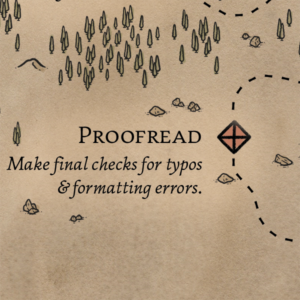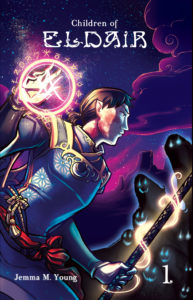 After your trek through the woods of design and copyediting, pause and catch your breath. Now is the time to proofread your work before you launch your voyage into the sea of publishing. Proofreading is a final check to make sure your gear (your words, design, etc.) is in order before publishing. [Read more…] about Proofreading Boulders
After your trek through the woods of design and copyediting, pause and catch your breath. Now is the time to proofread your work before you launch your voyage into the sea of publishing. Proofreading is a final check to make sure your gear (your words, design, etc.) is in order before publishing. [Read more…] about Proofreading Boulders
proofreading
New: Comic Book Ebook Design for Kindle
 Looseleaf now offers comic book ebook design for Kindle! The first two projects we’ve helped produce are Book 1 and Book 2 of Children of Eldair, a full-color portal fantasy comic by Jemma M. Young. (Looseleaf also copyedited and proofread Book 2.) You can buy both the ebooks and the gorgeously printed paperbacks on Amazon (Book 1 is available now; Book 2 is forthcoming), and when you’ve finished those off, you can see the latest pages on a regular basis at Eldair.com.
Looseleaf now offers comic book ebook design for Kindle! The first two projects we’ve helped produce are Book 1 and Book 2 of Children of Eldair, a full-color portal fantasy comic by Jemma M. Young. (Looseleaf also copyedited and proofread Book 2.) You can buy both the ebooks and the gorgeously printed paperbacks on Amazon (Book 1 is available now; Book 2 is forthcoming), and when you’ve finished those off, you can see the latest pages on a regular basis at Eldair.com.
File Formats for Comic Book Ebook Design
Ebooks aren’t usually the first option for comics. Most ebooks are reflowable, which means the text can shift around to let readers adjust the size and other aspects to suit their reading choices. Comics, with their rich, dense illustration and specifically placed text, don’t do well in a reflowable book. But if you want to publish a portable, electronic version of your ebook, don’t settle for a static PDF. The Kindle format is your best bet. Amazon has created a platform that readily integrates panel magnification in a way that keeps file sizes low while making it easy for readers to zoom in on intricate artwork, dialogue text, and more. EPUB format (which Nooks, iBooks, Kobo devices, and more use) can do similar things, but the code is more complex, and the files can become large, especially with detailed or lush artwork (like Jemma’s work with Children of Eldair). EPUB files need to be compatible with many different platforms and devices, while Kindle files wrangle only with different devices.
But even with a ready-to-run format, the time spent building an ebook is time you aren’t writing, drawing, inking, lettering, and/or coloring your comic. If you want a Kindle-ready version of your comic, trust Looseleaf with your story. We’ll get it reader ready. Need more information? Get a quote on your comic book ebook design.
Not a comic book writer? We’ve got you covered with standard print and ebook design pricing.
New Project: The Folklore Historian, Volume 29
My most recently completed editorial project isn’t technically a Looseleaf project—I’m the temporary managing editor for this one, not a freelancer, exactly—but I wanted to share it anyway. The last project was a novel, but this one was a scholarly journal focusing historical approaches to folklore (or folklore in a historical perspective). I present volume 29 of The Folklore Historian, a member of the American Folklore Society’s family of publications.
I didn’t do all the work on this issue. I took over at the beginning of the semester, so I proofread the final text, managed final revisions with the authors, laid the journal out in InDesign, designed the cover, and took the files to and checked the proofs from the press.
Looseleaf Proofreading
This week I’m going to look at each of Looseleaf’s editorial services and tell you what they are, when you need them, and some tricks you can use to do some editing yourself before you hire it out. Today is proofreading day.
What Is Proofreading?
Proofreading is a lot like copyediting, which I talked about yesterday, but with a few important differences. It’s still nuts-and-bolts editing, but it’s more restrained than copyediting. Proofreading is supposed to be the last thing that happens before a book is released (except fixing the errors found in proofreading, of course). This means that sometimes a proofreader will allow text through that isn’t ideal, but isn’t exactly wrong either. When I proofread I look for errors and inconsistencies that the author would change if he or she saw them, not for things I think should change. If it won’t make the author look like an idiot, at this point, it’s probably okay.
Proofreading also tackles an aspect copyediting leaves alone: formatting. Because I proofread on the final version of a manuscript, I make sure the final version looks the way it is supposed to. If there are font changes, I point them out for the typesetter; if there are words that are hyphenated in an unhelpful way, I suggest a different line break. I point out lines that are too spaced out, too cramped, or too short to stand on their own. I make sure page breaks happen at good points in the text and that there are no distracting patterns in the word spaces. (If you’re savvy to typesetting lingo, proofreaders look for bad breaks, widows, orphans, rivers, word stacks, and more.)
Proofreading is important for both print books and ebooks. Ebook formatting can get botched during creation or during conversion from one file format (e.g., .doc, .pdf, .indd) to another (e.g., .epub, .mobi, .amz), and it’s important to proofread the final version as it will be seen by your reader.
When Does a Manuscript Need Proofreading?
As you’ve probably gathered from my description of proofreading, it’s the very last thing you do. Proofreading should be done on manuscripts that have already been copyedited and that are deemed ready to be released. If you don’t have your manuscript in the final version for print or electronic distribution, proofreading isn’t for you yet. This can be an important distinction when you’re hiring someone. Most editors will be able to figure out if you’ve asked for proofreading when you actually wanted copyediting, but knowing the difference will help you search for the right editor.
How Can You Do Some Proofreading Yourself?
As with copyediting, I don’t recommend proofreading for yourself. That isn’t to say you’re incapable of catching the types of errors proofreaders focus on, but rather that when it comes to your own work it’s not advisable to rely on yourself. If someone has seen your manuscript before (unless it was a very different version), they’re probably the wrong person for your proofreading. I won’t proofread manuscripts I’ve already worked on; instead I choose one of my stellar editor friends, have them proofread it, and then review their work to make sure it’s in line with what the author and I have discussed in previous edits. This ensures that the author is getting the best editing possible. If I’m new to a manuscript, that means I’m the right person for the job. When it comes to your manuscript, you’ve seen it too many times to be qualified.
So instead of telling you how to proofread, I’m going to give you some tips on preparing to hand your manuscript over to a proofreader, whether you’re paying them or not. The best piece of advice I can give you is to make a style sheet. A style sheet gives your proofreader a map for how things should be, and it cuts down on the time a proofreader spends asking you questions. Here are a few things that should be in your style sheet:
- How you spell and capitalize characters’ names, place-names, theories, principles, and objects unique to your manuscript. (It’s also helpful to write out any acronyms you use.)
- What style guide you use for your citations (Chicago, APA, MLA, etc.).
- What color your characters’ eyes, hair, skin, etc. are. (Other personal details that need to be consistent—like age—are also very helpful.)
- Any facts that are particularly pertinent to making sure everything makes sense chronologically.
- Your stance on any ambiguous language issues you feel strongly about (e.g., who / whom). This also includes any unique spellings you have that deviate from dictionary standards (e.g., writing lifewriting as one word instead of two).
If you have a style sheet with your opinions and needs for the manuscript on it, you’ll have one extremely happy proofreader, which is almost as good as proofreading for yourself.
Other Editorial Services
Before You Hire an Editor, Know What You Need
Before you hire a freelance editor, you need to decide what type of editing you want right now. It’s also good to know what types of editing you’re going to want in the future; sometimes you can work with the same editor through the whole project, or you can at least work with people your editor refers you to.
You need to know what type of editing you need because editors are not wizards. You can’t take a book you think isn’t quite there, hand it off to an editor, and get it magicked into complete perfection. Editors can help you improve your writing and hone your craft, but they can’t force absolute quality on you (even if they could, it wouldn’t really be your book afterward). The clearer you can be about the type of help you want, the better an editor can help you. An editor cannot effectively edit everything from commas to character arcs all in one go. That takes multiple passes over a manuscript, and you, the author, should be revising after each pass to make sure the piece stays true to what you want it to be.
Writing a story or nonfiction piece means creating a path from beginning to end, and ideally that path will have scenic vistas along the way. Editing involves trying to make that path clear and enjoyable for your reader. If you take the path-making metaphor a bit farther, you’ll understand why you can’t have someone do story-level developmental editing and sentence-level copyediting at the same time. You don’t hire a lumberjack to pull weeds; you don’t hire a golf-course manicurist to move massive boulders. Understand the task you want to hire out so you can hire the right person.
Developmental Editing (Story Editing)
Developmental editing is large-scale editing. In this type of editing the editor makes sure there are no redwoods blocking the path you’re trying to create for the reader. It also includes pointing out any opportunities you may have missed. Perhaps you could have pulled more tension out of a character’s relationship; maybe you ignored an argument your opponents will make; then again, maybe you just have a big plot hole or lapse in logic. A developmental edit involves multiple editorial passes and a lot of editor–author interaction to hone and develop your plot or argument, tone, characterization, and more. This is the lumberjack-and-boulder-removal level of editing. If a developmental editor also tried to do copyediting along the way, he or she could easily miss some uncharacteristic dialogue because he or she was more focused on the punctuation of a nonrestrictive clause.
Learn more about developmental editing from this Looseleaf blog post. Another editing service that is related to developmental editing is the manuscript evaluation or critique.
Substantive Editing (Line Editing)
Substantive editing goes into more fine-tuning than moving boulders: it’s more like clearing the path of hedges and shrubbery and making sure it’s as direct as possible. Substantive edits cover organization, logical flow, word choice, internal consistency, and more. It can go as big as reordering paragraphs and as fine as tweaking a word to sustain your tone. Often a substantive edit can include a lot of copyediting because it is more sentence- and word-based than developmental editing. However, it should not be confused with a true copyedit. Substantive editing involves a lot of tweaking, reordering, and decision-making from the author. By the time the edit is done you’ll have changed a lot of text, and any time you make lots of changes you need to go back and make sure the details of those changes are clear.
Learn more about substantive editing from this Looseleaf blog post.
Copyediting
Copyediting looks at the potholes and pebbles along a manuscript’s path. The editor shifts word and punctuation debris so readers won’t twist their ankles while enjoying your story. Everything gets edited for grammar, spelling, punctuation, style, consistency, and adherence to your chosen citation format (this could be everything from the color of your characters’ eyes to how you capitalize certain words and phrases). Sometimes copyediting isn’t necessarily a right-or-wrong type of thing. There are some language scenarios in which you’ll have more that one option. It’s a copyeditor’s job to make sure you remain consistent in which option you choose.
Learn more about copyediting from this Looseleaf blog post.
Proofreading
Proofreading is a lot like copyediting in that it’s concerned with potholes and pebbles. However, a proofread is performed on the final version of a publication. It should always be done by someone who hasn’t previously edited your work (Looseleaf uses some trusted subcontractors to do the proofreading on projects I’ve already edited). The proofreader catches last-minute errors and items that you, the author, would change yourself if you had your attention drawn to them. Proofreaders also catch formatting errors like over-spaced lines, misplaced hyphens, widows and orphans, word stacks, and inconsistent typeface use. Anything that will disrupt the reader’s final experience gets caught during proofreading.
Learn more about proofreading from this Looseleaf blog post.
An Editorial Relationship
If you want a long-term working relationship with a particular editor, make sure you can get all the types of editing you’re going to need from that editor or from professional acquaintances of that editor. By working with one individual or a collection of close contacts, you’ll be better able to retain your vision and voice across the different stages of editing. For example, when I hire out final proofreading on projects I’ve edited, I review the proofreader’s changes to make sure they don’t go back on anything the author and I have previously talked about. This helps retain the author’s intentions and goals for the project.
Before you hire, know what you want. You’ll be happier with your final product and you’ll save a lot of negotiation with your editor if you can articulate what it is you want him or her to do.
Image by Rob Wiltshire via FreeDigitalPhotos.net




